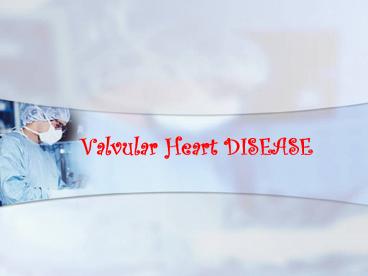Valvular Heart DISEASE - PowerPoint PPT Presentation
Title:
Valvular Heart DISEASE
Description:
Valvular Heart DISEASE * What is Valvular Heart Disease? What Are the Types of Valve Disease? There are several types of valvular heart disease, include: 1)Valvular ... – PowerPoint PPT presentation
Number of Views:948
Avg rating:3.0/5.0
Title: Valvular Heart DISEASE
1
Valvular Heart DISEASE
2
(No Transcript)
3
What is Valvular Heart Disease?
4
What Are the Types of Valve Disease?
- There are several types of valvular heart
disease, include - 1)Valvular stenosis When a valve opening is
smaller than normal - 2)Valvular Insufficiency/REGURGITATION occurs
when a valve does not close tightly, thus
allowing blood to leak backwards. - Both valvular diseases can involve all four
valves.
5
Types
- Mitral Stenosis
- Mitral Regurgitation
- Aortic Stenosis
- Aortic regurgitation
- Tricuspid valve is affected infrequently
- Tricuspid stenosis causes Rt HF
- Tricuspid regurgitation
- Pulmonary valve disease
6
What Causes Valvular Disease?
- Congenital mostly affect the aortic or
pulmonic valve , - Acquired .
- Other Acquired causes?
- Rheumatic fever
- Infective endocarditis
- Coronary artery disease
- Heart attack
- Cardiomyopathy (heart muscle disease)
- Syphilis .
- Hypertension .
- Aortic aneurysms .
- Connective tissue diseases
7
Rheumatic Heart Disease
- Inflammatory process that may affect the
myocardium, pericardium and or endocardium - Usually results in distortion and scarring of the
valves - Caused by a type 2 inflammatory reaction
secondary to sore throat caused by a bacteria
called S.pyogenes
8
Rheumatic Heart Disease, cont.
- Prior history of rheumatic fever
- General malaise
- Pain may or may not be present
- Murmurs
- Dyspnea
- polyarthritis
9
Infective endocarditis
- Infection of heart valves
- Commonly bacterial
- Results in damage to valve structure giving rise
to senosis or regurgitation
10
Mitral Stenosis
- Usually results from rheumatic carditis
- Is a thickening by fibrosis or calcification
- Can be caused by tumors, calcium and thrombus
- Valve leaflets fuse
- These narrows the opening and prevents normal
blood flow from the LA to the LV - LA pressure increases, left atrium dilates, PAP
increases, and the RV hypertrophies - Pulmonary congestion and right sided heart
failure occurs - Followed by decreased preload and CO decreases
11
(No Transcript)
12
Mitral Stenosis, cont.
- Mild asymptomatic
- With progression dyspnea, orthopneas, dry
cough, hemoptysis, and pulmonary edema may appear - Right sided heart failure symptoms occur later
- Signs
- Atrial fibrillation
- Apical diastolic murmur is heard
13
aortic stenosis
- characterized by an abnormal narrowing of the
aortic valve opening.
14
Causes of Aortic Valve Stenosis
- 1)Most commonly, aortic stenosis is due to
age-related progressive calcification - 3)Rheumatic aortic stenosis(10)
15
(No Transcript)
16
Clinical presentation
- Congestive heart failure
- Syncope
- Angina
17
Aortic Regurgitation
- is the leaking of the aortic valve of the heart
that causes blood to flow in the reverse
direction during ventricular diastole, from the
aorta into the left ventricle. - Causes
- Infective endocarditic
- Rheumatic disease
- Trauma
- Aortic dilatation like in Marfans Syndrome,
syphilis
18
Mitral Stenosis
- Usually results from rheumatic carditis
- Is a thickening by fibrosis or calcification
- Can be caused by tumors, calcium and thrombus
- Valve leaflets fuse
- These narrows the opening and prevents normal
blood flow from the LA to the LV - LA pressure increases, left atrium dilates, PAP
increases, and the RV hypertrophies - Pulmonary congestion and right sided heart
failure occurs - Followed by decreased preload and CO decreases
19
(No Transcript)
20
Mitral Stenosis, cont.
- Mild asymptomatic
- With progression dyspnea, orthopneas, dry
cough, hemoptysis, and pulmonary edema may appear - Right sided heart failure symptoms occur later
- Signs
- Atrial fibrillation
- Apical diastolic murmur is heard
21
- Mitral regurgitation
- -occurs when the mitral valve does not close
properly while the heart pumps out blood . - -Most common cause is mitral valve prolapse
(MVP) . - -Pathophysiology blood leaks back into LAgt
dilatation of LA gtreduction in LV systolic
functiongtlater LV dilatation. - -symptoms are (palpitation- dyspnea- edema-
fatigue- ascitis)
22
diagnostic tests
- Echocardiography .
- Transesophageal echocardiography .
- Cardiac catheterization .(also called an
angiogram) - MRI
23
(No Transcript)
24
(No Transcript)
25
Treatment of valvular heart disease
- Drugs to facilitate myocardial functioning
- Surgical-valve replacement/valve repair
26
Medial Treatment
- Nonsurgical management focuses on drug therapy
and rest - Diuretic, beta blockers, digoxin, O2,
vasodilators, prophylactic antibiotic therapy - Manage atrial fibrillation , if develops, with
conversion if possible, and use of anticoagulation
27
Surgical Management of Valve Disease
- Mitral Valve
- Mitral Valve Replacement
- Balloon Valvuloplasty
- Aortic Valve Replacement
28
Baloon valvuloplasty
29
Mechanical Valve
30
Mechanical Valve
31
Tissue Valve
32
Advantages of surgical repair
- Reducing progression into heart faliure
- better functional outcome
- Disadvantages
- Valve failure
- Some valves warrant life long anticoagulatioln
33
Thank you.































